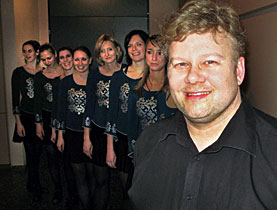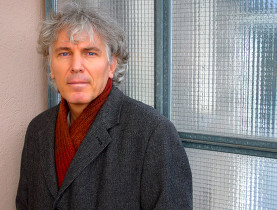Swiss instructor shares love of Irish dance

It's a Friday evening in Lucerne, but the soundtrack is clearly Irish.
Every week, students gather at the dance studio off Tribschenstrasse to practise their jigs and reels. Instructor Manfred Trinkler is there to greet them as they arrive – just as he has been doing for the past ten years.
The 42-year-old dance teacher from central Switzerland still vividly remembers his first encounter with Irish step dance – although he didn’t know what it was at the time.
“As a boy, I saw it in a circus, but I couldn’t see what it was exactly. There was a lady who was making noise with her shoes, and I couldn’t imagine what it was,” says Trinkler.
That rhythm and sound never quite left him. Trinkler was too shy to ask his folks if he could take dance lessons so he practised secretly on his own. He was 17 when he finally began taking lessons.
He learned other styles of dance as a teenager and went on to become an instructor in standard, Latin and hip-hop.
Years later, Michael Flatley and Jean Butler performed with their Riverdance troupe at the 1994 Eurovision Song Contest – launching a worldwide Irish dance craze.
Trinkler, who happened to be watching television that night, was electrified: “It was magic for me.” He immediately decided to add Irish step to his repertoire.
“I did special courses in London and in Dublin, Ireland. We had some very good trainers but we had to learn it very quickly. And after one and a half years I gave courses in Irish,” says Trinkler.
In January 1999, the Continental Irish Dance Academy was established in Lucerne.
“This was the idea of Ruth Linsenmaier and Gery Bucher, who have a dance school in Lucerne. They had connections with the world association of Irish dance and they were asked to offer some lessons in Switzerland, Germany, Austria and Hungary, but the office is here in Lucerne,” says Trinkler.
As one of the academy’s key instructors, Trinkler gives lessons in Lucerne, Zurich and Basel. The academy is also active in Bern and St Gallen.
Time and patience
Trinkler says there’s no such thing as a “typical” Irish dance student. In addition to women and men aged 20 to 40, there are also some children and teens. Most are Swiss.
While new students don’t need any experience, Trinkler says they do need patience.
“This kind of dance needs time, and you have to do some steps again and again. At first we had people who were sure that they could do three or four weeks and go on to Riverdance or Lord of the Dance, and I’m very sorry, but this is impossible – you have to train very hard for a long time.”
There are ten women in the Lucerne class, ranging in age from 19-34. Two of them have been attending Trinkler’s lessons since they were first offered a decade ago. Sisters Daniela and Patricia Weber, now 27 and 25, were teenagers when they got bitten by the step dance bug.
Patricia remembers how it all began:
“Together we watched the show Riverdance, and after the show, there was a boy who gave us a little card.” That card was a flyer describing Trinkler’s beginner course. Daniela was the first one who dared to give it a try, but she soon persuaded Patricia to join her.
According to Daniela: “It’s wonderful to dance Irish.” And both sisters agree that the lessons with Trinkler are a great way to spend a Friday night.
“I like his style. He’s always nice and friendly, but he can be very strict in teaching, and we really learn a lot,” says Patricia.
For Trinkler, the most rewarding part of the job is seeing a student make progress.
“The first lesson you might think, ‘Hmm, I don’t know. Is it OK for her or not?’ And three years later, you see that same person and she does some steps in Irish and it’s absolutely fantastic to see that.”
Earning applause
Last year, Patricia Weber had the opportunity to perform with SkyDance – an annual show that features a number of dance styles, including Irish.
“She started ten years ago when she was 15 years old, and now last year she started with the show. For me it was brilliant, a good feeling to see her in the show, and she was very, very happy,” says Trinkler.
In addition to his work as a dance instructor, Trinkler helps coordinate SkyDance. He has also performed in the show, which debuted in 2002 and tours through Switzerland every year.
“A big part of this show is Irish dance. We have ceilis, soft shoes, hard shoes – it’s fantastic. And at the end, we have a very long line of dancers and it’s absolutely fantastic to stand in that line and smile and see the audience,” says Trinkler.
Meanwhile, Trinkler’s intermediate students also perform at smaller events like birthday parties and other private functions. For the past few years, his students have also danced at the HELA, an autumn festival held in Laufenburg, Aargau. The students find these occasional gigs very motivating.
“I think everybody is happy in this class to learn some new steps, to learn some new choreos, and then you can perform for an audience and they like it and everybody’s happy. It’s a good feeling,” says Trinkler.
While the Riverdance farewell tour is scheduled to end in 2010, Trinkler has no plans to quit.
“When I started ten years ago, I was sure it would run just one or two years. Now it’s been ten years and I’m sure it won’t stop next year.”
Judging by the audience’s reaction at a recent show, it looks like there is still plenty of applause in store for Trinkler and his troupe of Swiss Irish dancers.
swissinfo, Susan Vogel-Misicka in Lucerne
Professional Irish dancers typically start at around age 4. When Michael Flatley began taking lessons at age 11, his teacher said he was already too old. However, the Irish-American went on to launch the following major dance shows: Riverdance, Lord of the Dance, Feet of Flames and Celtic Tiger.
Soft shoes: Not all Irish dance is noisy. Dances performed in soft shoes feature more leaping and ballet-like movements. Made of soft leather, these shoes lace up and have very thin and narrow soles.
Hard shoes: Equipped with fibreglass toes and heels, these sturdy buckled shoes produce the tapping sound that punctuates Irish step dance. The sound is quite different from that of American tap shoes, which have metal toe tips and heels.
Ceili (kay-lee): The word “ceili” is Irish for “party”. Ceili dancing, also called set dancing, is a social form of dance similar to square dancing. It’s often done in Irish pubs around the world.

In compliance with the JTI standards
More: SWI swissinfo.ch certified by the Journalism Trust Initiative


You can find an overview of ongoing debates with our journalists here. Please join us!
If you want to start a conversation about a topic raised in this article or want to report factual errors, email us at english@swissinfo.ch.